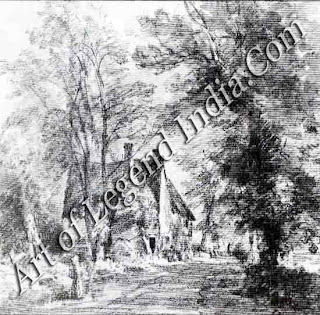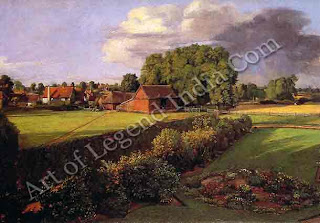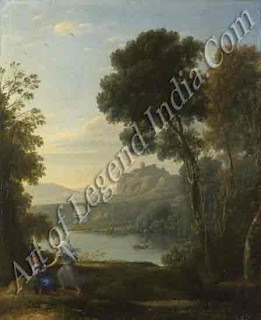Scenes of the Stour Valley
 Constable's
strongest inspiration came from the scenes of boyhood, which he said 'made me a
painter'. The few square miles of Suffolk around East Bergholt are now known as
Constable Country.
Constable's
strongest inspiration came from the scenes of boyhood, which he said 'made me a
painter'. The few square miles of Suffolk around East Bergholt are now known as
Constable Country.
Constable
is often described as the greatest painter of the English landscape, but it is
truer to call him the painter of Suffolk, or rather the Stour valley the 12
square miles around his birthplace in East Bergholt, which even in his own day
became known as Constable Country. He could never bring his extraordinary gifts
to bear on a landscape which held no personal meaning for him. Apart from
Suffolk, only Hampstead, Salisbury and to a lesser extent Brighton stimulated
the intense observation and passionate feeling which the hall-mark of his best
paintings.
Constable
seems to have realised where his genius lay in 1802, while studying at the
Royal Academy in London. He wrote to his old sketching companion John
Dunthorne, the village glazier, that he was determined to come home and study nature,
the source of all originality in art. His plan was to make a 'pure and
unaffected representation of the scenes of his childhood. With this end in
mind, he not only spent that summer and autumn in East Bergholt, but also
bought a cottage in the village to use as a permanent studio.
THE SUMMER SKETCHBOOKS
Almost
every summer for more than 15 years he returned to the village to make detailed
records in his sketchbooks of every object, activity or view that caught his
interest. The summer of 1813 was particularly valuable. The weather was
magnificent, and Constable walked daily in the Stour valley, sketching
obsessively. 'I almost put my eyes out with that practice', he wrote later.
His
sketchbook for that year has fortunately been preserved, and clearly shows his
working methods. The tiny drawings measure no more than 3½" x 4¾",
but cover an extraordinary range of subjects: the river and its barges, sheep
sheltering from the heat under a tree, cottages, farms and churches, mooring
posts and water lilies, ploughmen and their horses, and dozens of little
details, including the cuff of a jacket. Many amounts to fully realised
compositions and almost all the rural themes which he later illustrated in his
paintings are seen here.
These
scenes, Constable said, made him a painter, and his feeling for their visual
beauty was enhanced by his understanding of the work being done in the locks
and towpaths, boatyard and meadows. His apprenticeship in his father's mills
had taught him not to look only at the buildings, trees and people. He watched
the sky too and the river with the professional eye of a miller, whose
livelihood depended on understanding the weather and its ever-shifting moods.
 Yet
despite Constable's devotion to Suffolk and its countryside, the great majority
of the finished works were painted not in East Bergholt, but in London with the
sketchbooks and some small oil-studies serving as 'notes'. Just one early
picture, Boatbuilding, was completed in the open air; the other major canvases
were painted in his London studio during the winter months.
Yet
despite Constable's devotion to Suffolk and its countryside, the great majority
of the finished works were painted not in East Bergholt, but in London with the
sketchbooks and some small oil-studies serving as 'notes'. Just one early
picture, Boatbuilding, was completed in the open air; the other major canvases
were painted in his London studio during the winter months.
For the
famous 'six-footers' exhibited at the Royal Academy, Constable went through one
more stage of preparation which is probably unique amongst artists: he painted
a full-size oil sketch, to work out the composition and blocks of colour he
would finally use. These sketches have also been preserved and are much admired
by modem critics for the freedom with which he used his palette knife to apply
the paint, capturing the effects of the English weather with all its changes.
THE GREAT CANAL SCENES
But the
finished versions of the great canal scenes show Constable's genius at its
height. Here, as nowhere else, he captured the atmospheric effects of early
summer in the open air, the movement of clouds across the broad Suffolk sky and
the impact of sunlight on the waters of his beloved Stour.
To
convey on canvas the sun's rays glittering on the river surface and dancing on
the foliage of trees agitated by the wind, Constable abandoned the 'fiddle
browns' of traditional landscape painting for the true colours and textures of
nature. Restricted by the paints available to him, he used pure yellow and
white for the flash of sunlight on dew, and captured the motion of clouds and
the racing wind with rapid, nervous brushwork whose sensitivity has never been rivalled.
Writer
– Marshall Cavendish
 Constable's
strongest inspiration came from the scenes of boyhood, which he said 'made me a
painter'. The few square miles of Suffolk around East Bergholt are now known as
Constable Country.
Constable's
strongest inspiration came from the scenes of boyhood, which he said 'made me a
painter'. The few square miles of Suffolk around East Bergholt are now known as
Constable Country. Yet
despite Constable's devotion to Suffolk and its countryside, the great majority
of the finished works were painted not in East Bergholt, but in London with the
sketchbooks and some small oil-studies serving as 'notes'. Just one early
picture, Boatbuilding, was completed in the open air; the other major canvases
were painted in his London studio during the winter months.
Yet
despite Constable's devotion to Suffolk and its countryside, the great majority
of the finished works were painted not in East Bergholt, but in London with the
sketchbooks and some small oil-studies serving as 'notes'. Just one early
picture, Boatbuilding, was completed in the open air; the other major canvases
were painted in his London studio during the winter months. 












0 Response to "British Great Artist John Constable - Scenes of the Stour Valley "
Post a Comment